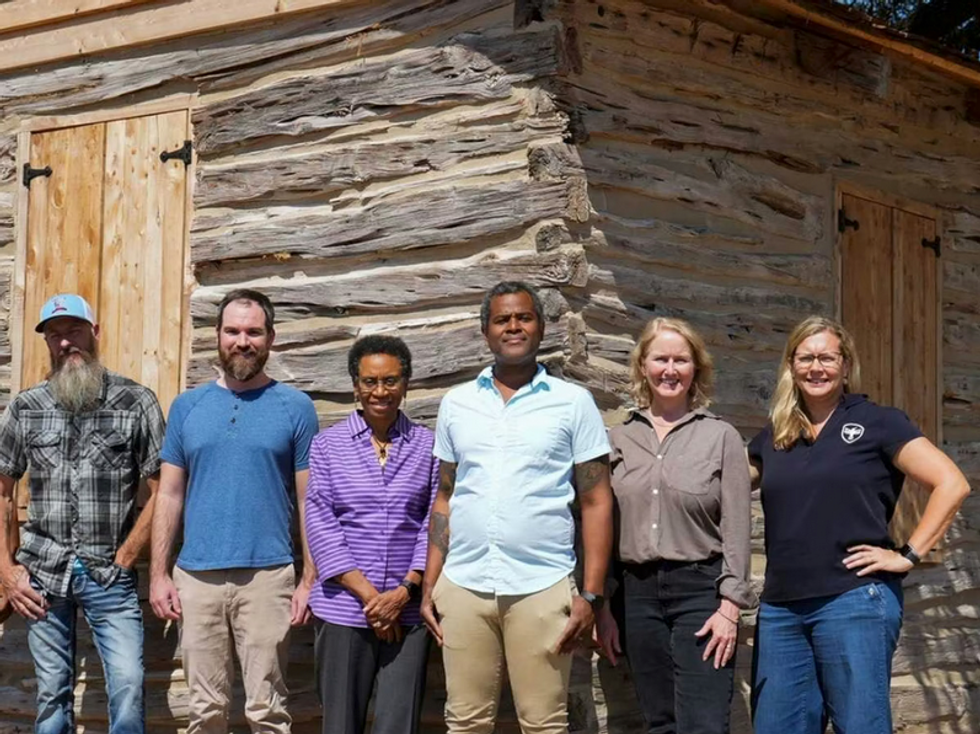new opening
'Banned, Burned, Seized, and Censored': Exploring the machinery of censorship atthe Ransom Center
 After Boston banned his novel Oil!, Upton Sinclair took to the city's streetsselling a special "fig leaf" edition. Sinclair had solid fig leaves printed onpages in place of objectionable text.
After Boston banned his novel Oil!, Upton Sinclair took to the city's streetsselling a special "fig leaf" edition. Sinclair had solid fig leaves printed onpages in place of objectionable text.
 Morris L. Ernst (left, holding book) was one of the most active attorneys forthe anti-censorship cause during the interwar years. In this 1935 photograph,from the New York Journal American, Ernst defends the Gustavo Flaubert'sNovember.
Morris L. Ernst (left, holding book) was one of the most active attorneys forthe anti-censorship cause during the interwar years. In this 1935 photograph,from the New York Journal American, Ernst defends the Gustavo Flaubert'sNovember. Henry Miller's Tropic of Cancer (1934) was deemed obscene by the United StatesCustoms Department and as such could not be brought into the United States. Thebook was cleared of obscenity charges by the United States Supreme Court in1964.
Henry Miller's Tropic of Cancer (1934) was deemed obscene by the United StatesCustoms Department and as such could not be brought into the United States. Thebook was cleared of obscenity charges by the United States Supreme Court in1964. This 1942 poster reminded Americans of the widespread 1933 Nazi book burningsand presented books as playing a fundamental role in the fight against tyranny.Image courtesy of the Harry Ransom Center.
This 1942 poster reminded Americans of the widespread 1933 Nazi book burningsand presented books as playing a fundamental role in the fight against tyranny.Image courtesy of the Harry Ransom Center. Samuel Roth published this pirated edition of Lady Chatterley's Lover. Thisedition didn't have D. H. Lawrence's authorization and was the second piratededition Roth produced.
Samuel Roth published this pirated edition of Lady Chatterley's Lover. Thisedition didn't have D. H. Lawrence's authorization and was the second piratededition Roth produced.
In the age of the Kindle, it's easy to forget that books can be dangerous.
A paperback bonfire isn't just something out of Fahrenheit 451—they've happened here in the U.S. A new exhibit opening today, September 6, at the Harry Ransom Center at the University of Texas explores censorship through a close-up look at the phenomenon in the United States between World Wars I and II. “Banned, Burned, Seized, and Censored,” which runs through January 22, 2012, features more than 200 items, drawn largely from the Ransom Center's holdings, to examine a period in which countless books, plays, magazines and images were pulled from the public eye in America in less than three decades.
Books and other media have been burned up, blacked out and removed from bookstores and libraries for many reasons, including political or religious oppression or protest. But in the United States, censorship has often come down to prudery, with its timeless rallying cry: “Won't somebody please think of the children?”
That's essentially the story told in the Ransom Center exhibit, which groups its materials by censoring organization, from the fiery New York Society for the Suppression of Vice, who raided the Gotham Book Mart, snatching up piles of books and sorting out the indecent ones later (the Society's woodcut logo portrayed an indecent person being tossed in jail and a top-hatted, waist-coated gentleman tossing books in a smoky pyre), to the United States Post Office, which indicted Mary Ware Dennett, a single mother who had distributed by mail a mild sex education pamphlet she had written in order to educate her sons.
The Ransom Center's unique collections gave them the opportunity to fully characterize both sides of the censorship issue. Ransom Center Assistant Director and Curator for Public Programs Danielle Sigler argues for the humanization of the censors. Even if we disagree with their actions, she says, “I think they were very earnest.”
Some of the books banned during the 1920s and 30s seem tame today, like Lady Chatterley's Lover (of author D.H. Lawrence, Sigler says “he was trying to ask questions about how people connect” beyond the sexual relationship at the center of the book, so “it feels sort of dated.”). Other books, like Henry Miller's Tropic of Cancer, is still pretty shocking in its graphic depiction of sex. A few address subjects that are still relevant, if less taboo now, like Radclyffe Hall's The Well of Loneliness, a novel about a lesbian that was censored in spite of the fact that it contains no sexual language.
This era of censorship would seem less accessible to contemporary audiences than the more familiar obscenity battles in the 40s and 50s, during the Beat era, over writings like Allen Ginsberg's Howl. But the Ransom Center's collections are uniquely useful for an exploration of this earlier era. “I think having an exhibit that is removed from someone's immediate context is useful," says Sigler. “Maybe it makes you stop a little bit and think more about the context and connections to today."
So, is old-fashioned book censorship still a danger? Perhaps not—Sigler says the vice organizations that drove book burnings and bannings in the 20s couldn't exist in the same form today, because “legally, there aren't that many restrictions on publishers and booksellers,” but suppression of publications comes in other forms. “Now, people tend to focus on school and public libraries for the same reason: the protection of children,” Sigler explains. “In a lot of ways the rhetoric hasn't changed, but maybe the venue has shifted.”
The digital era has its own brand of censorship, too. Sigler says the authors of Ulysses “Seen”, a graphic novel version of James Joyce's book, were ordered to remove depictions of nudity from their book when they created an iPad app for Apple.
Lots of related programming accompanies the exhibit, including a cooking class at the North Lamar Central Market on Friday, September 30, at 6:30 p.m., where Chef Louis Ortiz will demonstrate and sample food inspired by the exhibition. Graphic novel lovers can check out a discussion of Ulysses “Seen”, by the tribute's authors Mike Barsanti and Rob Berry—that's Thursday, October 13, at 7 p.m. And Isaiah Sheffer from the public radio program Selected Shorts hosts readings from the exhibition's featured works on Thursday, November 3, at 7 p.m. in the Jessen Auditorium.
“Banned, Burned, Seized, and Censored” is on view in the Ransom Center Galleries for the next five months. Hours are Tuesday through Friday, 10 a.m. to 5 p.m. (open until 7 p.m. on Thursdays), and Saturday and Sunday noon to 5 p.m. The galleries are closed Mondays.
---
CultureMap Banned-Books Recommendations
Plenty of the books featured in "Banned, Burned, Seized, and Censored" are still great reads. CultureMap has a few suggestions for pre- or post-exhibition reading. Grab them for your e-reader, or go old school with a classic paperback.
Ulysses by James Joyce
Read it. The whole thing. We dare you. Then check out a lecture by Brett Gary, Associate Professor of Media, Culture, and Communication at New York University, on Thursday, September 2, at 7 p.m. at the Ransom Center on "The Importance of Being Morris L. Ernst - The Man Who Took on the Censors and Freed Ulysses."
Oil! by Upton Sinclair
Paul Thomas Anderson's strange, wonderful There Will Be Blood is (very) loosely based on Sinclair's story of the clash between an oil tycoon and his son. Idealistic young socialists, fervent evangelists, petroleum-rich families, and a motel sex scene racy enough to get the book banned in Boston? Sounds as epic as the film it inspired.
Tropic of Cancer by Henry Miller
This is probably the most genuinely dirty book featured in the exhibit. Banned in the States until a quarter century after it was first published, this sprawling account of Miller's life as a struggling writer, with lots of frankly described sex, is also gorgeously written, from its earliest lines: "We are all alone here, and we are dead."
The Children's Hour by Lillian Hellman and The Well of Loneliness by Radclyffe Hall
Controversial for their portrayal of lesbian characters. Hellman's play about a schoolgirl who accuses two female teachers of having an affair still resonates with its examination of gossip and the thin line between public and private life for educators. It was banned in Boston. Hall's novel of an upperclass woman with "sexual inversion" (a veiled reference to homosexuality) was one of the best known lesbian novels of its era. Hardly racy, its plot still feels relevant, particularly its depiction of a lesbian couple who are mistreated by hospital staff when one becomes ill.

 The Neill-Cochran House Museum's mid-19th-century slave quarters received Planning and Historic Designation grant support for restoration and historical interpretation.Photo courtesy of Preservation Austin
The Neill-Cochran House Museum's mid-19th-century slave quarters received Planning and Historic Designation grant support for restoration and historical interpretation.Photo courtesy of Preservation Austin Built around 1863, the Henry G. Madison cabin in Rosewood Park received Bricks and Mortar grant support for preservation planning work.Photo courtesy of Preservation Austin
Built around 1863, the Henry G. Madison cabin in Rosewood Park received Bricks and Mortar grant support for preservation planning work.Photo courtesy of Preservation Austin